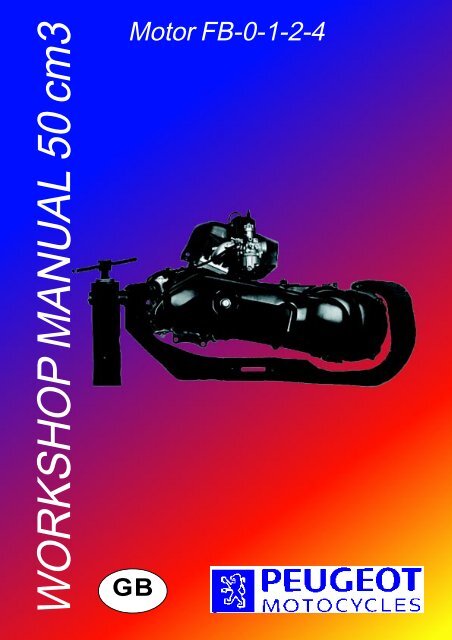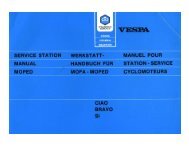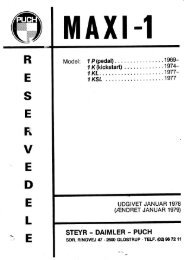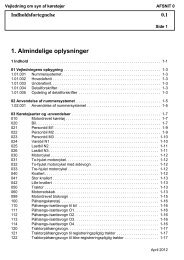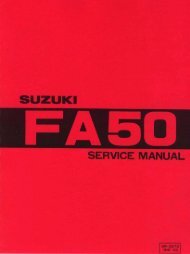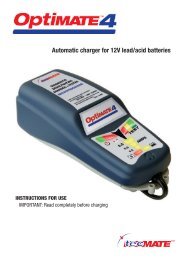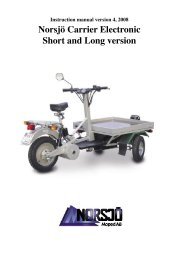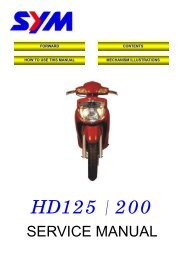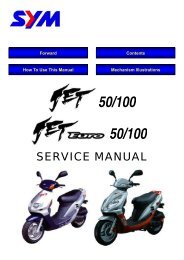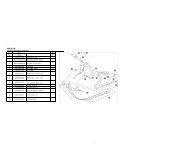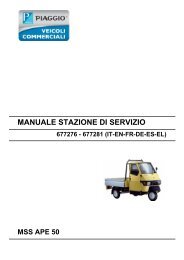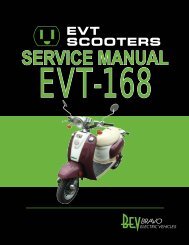Peugeot motor FB-0-1-2-4 workshop manual 50 cm3 - Scootergrisen
Peugeot motor FB-0-1-2-4 workshop manual 50 cm3 - Scootergrisen
Peugeot motor FB-0-1-2-4 workshop manual 50 cm3 - Scootergrisen
You also want an ePaper? Increase the reach of your titles
YUMPU automatically turns print PDFs into web optimized ePapers that Google loves.
WORKSHOP MANUAL <strong>50</strong> <strong>cm3</strong><br />
Motor <strong>FB</strong>-0-1-2-4<br />
GB
CONTENTS<br />
ENGINE PART CYCLE PART<br />
Designation Page<br />
- Contents, ............................................................. 1<br />
- Main characteristics, ............................................ 2<br />
- Maintenance plan,................................................ 3<br />
- Putting into service, ............................................. 4<br />
- Special tools,........................................................ 5<br />
- Tightening torques ............................................... 5<br />
Dismantling<br />
Designtation Page<br />
- Removing the engine from the vehicle, ............... 6<br />
- Placing the engine on the support, ...................... 6<br />
- Removing the cooling system, ............................. 6<br />
- Removing the flywheel, ........................................ 6<br />
- Removing the oil pump, ....................................... 7<br />
- Removing the starter <strong>motor</strong>, ................................. 7<br />
- Removing the carburettor and choke, ................. 7<br />
- Removing the intake valve and connecting part, . 7<br />
- Removing the complete primary drive assy, ........ 7<br />
- Removing the kick starter system, ....................... 8<br />
- Removing the relay unit, ...................................... 8<br />
- Removing the cylinder head, ............................... 8<br />
- Removing the cylinder piston assy,...................... 9<br />
- Removing the RH housing, .................................. 9<br />
- Removing the crankshaft from the LH housing, .. 9<br />
- Replacing the crankshaft bearings and seals,.. .... 9<br />
- Checking the crankshaft ...................................... 9<br />
Refitting<br />
Designation Page<br />
- Refitting the crankshaft, ..................................... 10<br />
- Closing the engine housings,............................. 10<br />
- Refitting the piston, ............................................ 10<br />
- Refitting the cylinder, ......................................... 11<br />
- Refitting the cylinder head, ................................ 11<br />
- Refitting the relay unit, ........................................ 11<br />
- Refitting the kick starter system,........................ 12<br />
- Checking the driven pulley clutch, ..................... 12<br />
- Checking the drive pulley variator, ..................... 12<br />
- Refitting the primary drive, ................................. 12<br />
- Refitting the intake valve and connecting part, .. 13<br />
- Refitting the carburettor, .................................... 13<br />
- Refitting the starter <strong>motor</strong>, ................................. 13<br />
- Refitting the oil pump and setting, ..................... 14<br />
- Refitting the flywheel,......................................... 14<br />
- Refitting the cooling system ............................... 14<br />
Trekker - Squab<br />
Designation Page<br />
- Contents, .............................................................. 1<br />
- Main characteristics, ............................................ 2<br />
- Maintenance plan,................................................ 3<br />
- Putting into service, .............................................. 4<br />
- Tightening torques, ............................................... 5<br />
- Disc brake ........................................................... 14<br />
RECOMMENDATIONS<br />
Designation Page<br />
- Spark plug............................................................. 2<br />
- Fuel ...................................................................... 4<br />
- Separate lubrication .............................................. 4<br />
- Relay unit ............................................................. 4<br />
ELECTRIC EQUIPMENT<br />
Designation Page<br />
- Electronic ignition, ............................................... 15<br />
- Circuits supplied with alternative current, ........... 15<br />
. lighting,............................................................. 15<br />
. choke, .............................................................. 16<br />
- Resistance check of stator, ................................ 16<br />
- Circuits supplied with direct current, .................. 17<br />
. battery charge, ................................................. 17<br />
. fuel gauge, ........................................................ 18<br />
. oil gauge, ......................................................... 18<br />
. horn, .................................................................. 18<br />
. indicators, .......................................................... 18<br />
. starter <strong>motor</strong> circuits, ....................................... 19<br />
- Functional diagrams for electric circuits,. 20 and 21<br />
- Key to electric circuits ........................................ 22<br />
1
Number<br />
Type<br />
Main spécifications<br />
ENGINE MARKING<br />
XXXXXXXX<br />
<strong>FB</strong>2<br />
<strong>FB</strong>2 ENGINE<br />
Forced-air cooled 2 stroke engine :<br />
- Bore and stroke : ................................................ 40 x 39.1<br />
- Cylinder capacity : ............................................. 49.13<strong>cm3</strong><br />
- Compression ratio : ................................................... 6.6:1<br />
- Maximum power (ISO) : ..........................................3.1 kw<br />
Distribution :<br />
- Exhaust port : ........................................................... 160c°<br />
- Scavenging port : ....................................................... 110°<br />
- Air intake : ..................................... by reed valve induction<br />
- Ignition : ....................... CDI (capacitive-discharge ignition)<br />
- Spark advance : ....................................... 13° before TDC<br />
- Spark plug ...................................................Resistive 5KÙ<br />
..................................................................... NGK - BR7HS<br />
.................................................................. EYQUEM R 8<strong>50</strong><br />
................................................................. BOSCH WR4AC<br />
- spark plug gap : ..................................................... 0.6mm<br />
Carburettor : .......................................... GURTNER PA3<strong>50</strong><br />
- Idling speed : .................................... 1800 rpm ± 1 00 rpm<br />
- Initial position of the pilot air adjusting screw :<br />
- Anticlockwise rotation : ..................................... 1/2 to 13/4<br />
- Needle with 3 levels : .................................. clips at the top<br />
- Main jet :........................................................................ 74<br />
Flywheel magneto :<br />
- Number of poles : ............................................................ 6<br />
- Power : .......................................................... 2<strong>50</strong>0t = 55w<br />
........................................................................ <strong>50</strong>00t = 85w<br />
Starter.<strong>motor</strong> : .................................................... MITSUBA<br />
................................................................ 2000w SM10 129<br />
................................................................. 1<strong>50</strong>0w SM10254<br />
Oil pump : .............................................................. MIKUNI<br />
flow 24<strong>cm3</strong> ± 1.7<strong>cm3</strong> / hour at 3800 rpm, wide open<br />
throttle. 1CM3 = 0.031 cubic inch<br />
2<br />
Transmission<br />
- Clutch : .................................... centrifugai, automatic type<br />
- Primary réduction gear : ........................ by a ribbed V-beit<br />
- Life of belt : ...................................................... 1 0 000 km<br />
- Reducer equipped with 2 gearsets.<br />
TECHNICAL DATAS<br />
Trekker - Squab<br />
Frame<br />
IDENTIFICATION MARK<br />
Identification<br />
plate<br />
Identification : VGAS1A . . . . . . . . . . .<br />
- Front tyre : ...................................................... 120/90 x 10<br />
- Rear tyre : ...................................................... 130/90 x 10<br />
Pressure :<br />
- Front : .................................................................... 1,3 bar<br />
- Rear : .................................................................... 1,6 bar<br />
Capacities<br />
- Fuel tank : .............................................................. 6 litres<br />
- Oil tank : .............................................................. 1.3 litres<br />
- Transmission case : ............................................ 0.12 litre<br />
- Under-seat storage compartment : ............................. 3 kg<br />
Dimensions<br />
- Overall length : ....................................................1760mm<br />
- Overail width : ........................................................670mm<br />
Excluding rear view mirror :<br />
Overall height : ...................................................... 1110mm<br />
Excluding rear view mirror :<br />
Wheelbase : ..........................................................12<strong>50</strong>mm<br />
Weight<br />
- Complete vehicle dry weight : .................................... 82kg<br />
- Vehicie weight with tanks full : ................................... 88kg<br />
Markings 49cc<br />
- Left hand casing (under the starter <strong>motor</strong>)<br />
- Cylinder head (front right)<br />
- Cylinder (exhaust flange left hand side)<br />
- Intake pipe (on the front «49»)
MAINTENANCE<br />
MAINTENANCE PLAN<br />
Depending on how the scooter is used, it is recommended to apply either - The normal maintenance plan or<br />
- The reinforced maintenance plan.<br />
The normal maintenance plan includes:<br />
- Visit at <strong>50</strong>0 km or 3 months Plan A<br />
- Periodic maintenance every <strong>50</strong>00 km Plan B<br />
- Periodic maintenance every 10000 km Plan C<br />
The reinforced maintenance plan includes:<br />
- Visit at <strong>50</strong>0 km Plan A<br />
- Periodic maintenance every 2<strong>50</strong>0 km Plan B<br />
- Periodic maintenance every <strong>50</strong>00 km Plan C<br />
The reinforced maintenance is intended for vehicles used in so-called “severe” conditions: door to door sales, intensive urban<br />
use (courrier), short journeys engine cold, areas with dusty atmospheres, frequent use of vehicles at an ambient temperature<br />
above 30°C.<br />
PLAN A PLAN B<br />
PLAN C<br />
CHECK :<br />
<strong>50</strong>0 km or 3 mois <strong>50</strong>00 km or 2<strong>50</strong>0 km* 10000 km or <strong>50</strong>00 km*<br />
Idle speed adjustment X X X<br />
Throttle X X X<br />
Oil pump control X X X<br />
Functioning of the electric equipment X X X<br />
Front and rear brake control X X X<br />
Fuel pipes X X X<br />
Oil pipes X X X<br />
Front brake fluid pipes X X X<br />
State and pressure of tyres X<br />
State, pressure and wear of tyres X X<br />
Brake fluid level X X X<br />
Level of battery electrolyte X X X<br />
Tightening of nuts and bolts X X X<br />
REPLACE :<br />
Relay unit oil X X<br />
Spark plug X X<br />
Filter element of the intake silencer X X<br />
Front brake pads (if necessary) X<br />
Rear brake linings (if necessary) X X<br />
Drive pulley rollers (if necessary) X X<br />
Transmission belt X<br />
CHECK AND UNCLOG<br />
Piston X<br />
Cylinder head X<br />
Exhaust port X<br />
CHECK AND LUBRICATE<br />
Driven pulley :<br />
movable driven face and needle bearing X<br />
Drive pulley :<br />
movable drive face and rollers X<br />
Kick : driven gear and link ring X<br />
CLEAN AND ADJUST<br />
Carburettor X<br />
VEHICLE TEST<br />
Road test X X X<br />
Trekker - Squab<br />
* reforced maintenance<br />
3
4<br />
INSTRUCTIONS FOR MAKING OPERATIONAL<br />
1. Preparation of the battery<br />
(dry charged)<br />
- Remove the battery.<br />
- Remove the six cell caps and the breather tube cap.<br />
- Fill the battery with électrolyte up to the level marked<br />
UPPER LEVEL (35% sulphuric acid 1.28 g/CM3),<br />
Ref :........................................................... 1 litre : 752740<br />
................................................................ 5 litres : 752741<br />
- Leave the battery to settle for half an hour. Top up the<br />
level if necessary.<br />
- Charge the battery for 1 to 2 hours with a current of<br />
400m.A (0.4A).<br />
- Replace the battery and connect the breather tube.<br />
- Connect up the red positive leads to the battery positive<br />
terminal, then the green negative lead to the battery earth<br />
terminal.<br />
- From then on, the battery can be topped up if necessary,<br />
using distilled water only.<br />
2. Fuel<br />
Capacity : .............................................................. 6 litres<br />
- Conventional 4-star petrol.<br />
- Lead free petrol 98 octanes.<br />
3. Separate lubrication:<br />
Capacity : .......................................................... 1.3 litres.<br />
- Fill up the oil tank with semi-synthetic engine oil for 2stroke<br />
engines with separate lubrication,<br />
- Type TC (API standard), type TSC3 (ASTM standard), -<br />
- Type FC (JASO standard) or a synthetic oil.<br />
PEUGEOT MOTOCYCLES recommends :<br />
....................................... ESSO : 2T Special performance<br />
......................................................... ESSO : 2T Synthetic<br />
Trekker - Squab<br />
4. Putting fuel and oil circuits into<br />
opération:<br />
- Put one litre of fuel mixture with 4% oil into the fuel tank.<br />
- Fill up the oil tank.<br />
- Start the engine: make sure that the oil circuit is<br />
completely primed. Remove the oil bleed screw from the<br />
pump to allow air in the circuit to escape. When a<br />
continuons stream of oil issues from this hole, replace the<br />
bleed screw with its fiber washer.<br />
For this : disconnect the oil intake hose to the carburettor<br />
and check that it drips, frequency depending on the<br />
engine’s speed.<br />
- Top up the fuel tank with pure 4 star petrol.<br />
5. Checking the oil level in the<br />
transmission case:<br />
- Unscrew and remove the oil filler hole screw A and<br />
make sure that the oil level is flush with the level of the<br />
filling hole. The vehicle must be positioned on its stand<br />
and on a level surface.<br />
Esso Oil SAE 80 W 90<br />
REF : .................................................................... 753009<br />
capacity 0. 1 2 litre<br />
A = 1.2m.daN.<br />
6. Checks before delivery to the<br />
customer:<br />
- In particular, check the tightening of the Wheel nuts ... -<br />
front : .................................................................... 6m daN<br />
- rear : .............................................................. 1Om daN<br />
- Check the tightness of the nuts and bolts.<br />
- Check brake adjustment and eff iciency.<br />
- Cold tyre pressure:<br />
FRONT<br />
- pressure : ......................................................... 1.3 bar<br />
- size : .......................................................... 120/90 x 10<br />
REAR<br />
- pressure : ......................................................... 1.6 bar<br />
- size : .......................................................... 130/90 x 10<br />
- Make sure all lights and signals operate correctly<br />
(taillight, turnsignals, stop light, horn), and various<br />
warning lights.<br />
- vehicle road test.
Engine<br />
TIGHTENING TORQUES AND SPECIAL TOOLS<br />
TIGHTENING TORQUES SPECIAL TOOLS<br />
Assembly screws for :<br />
- Housings : ........................................................ 1m.daN<br />
- Covers : ............................................................ 1m.daN<br />
- Intake connecting part : .................................... 1m.daN<br />
- Starter <strong>motor</strong> : .................................................. 1m.daN<br />
- Stator :.............................................................. 1m.daN<br />
- Sensor : ............................................................ 1m.daN<br />
- Fan : ................................................................. 1m.daN<br />
- Carburettor : .................................................. 0.8m.daN<br />
- Oil pump : ...................................................... 0.8m.daN<br />
- Cylinder head : .............................................. 1.2m.daN<br />
- Drive pulley : ..................................................... 4m.daN<br />
- Driven pulley : ................................................ 4.5m.daN<br />
- Rotor : .............................................................. 4m.daN<br />
- Oil plug : ........................................................ 1.2m.daN<br />
- Spark plug : ...................................................... 2m.daN<br />
Frame<br />
- Front wheel axis nut : ........................................ 6m.daN<br />
- Rear wheel nut : ............................................. 10m.da N<br />
- Engine joint on rod :........................................... 6m.daN<br />
- Rod joint on chassis : ..................................... 2.2m.daN<br />
- Rear shock absorber upper fixation : .............. 1.6m.daN<br />
- Rear shock absorber lower fixation : .............. 1.6m.daN<br />
- Exhaust nuts on cylinder : .............................. 1.6m.daN<br />
- Handlebar nut : .................................................. 4m.daN<br />
- Steering lock nut : .............................................. 7m.daN<br />
Standard<br />
- Screw and nut ø 5mm : ...................... 0.45 to 0.6m.daN<br />
- Screw and nut ø 6mm : ........................ 0.8 to 1.2m.daN<br />
- Screw and nut ø 8mm : ........................ 1.8 to 2.5m.daN<br />
- Screw and nut ø 1Omm : ........................... 3 to 4m.daN<br />
- Screw and nut ø 12mm : ............................ 5 to 6m.daN<br />
Trekker - Squab<br />
- Service cradle mount ............................................... 64765<br />
- Adjustable adapter for engine service cradle ......... 752026<br />
- Flywheel holder ....................................................... 68570<br />
- Snap ring pliers ..................................................... 752000<br />
- Protective end, small model for flywheel magneto remover<br />
.................................................................................. 68007<br />
- Puiler tool ................................................................ 64706<br />
- Crankshaft end protector ......................................... 69098<br />
- Shouldered centring tool .......................................... 64710<br />
- Screw on torque handle ........................................... 69104<br />
- Compresser tool, ail types of clutch ....................... 752127<br />
- Tubular socket wrench 39 ..................................... 752361<br />
- Adjustable pin type face wrench ............................ 752237<br />
- Set of half sheils 0 52 .............................................. 64709<br />
- Puiler tool .............................................................. 7<strong>50</strong>807<br />
- Support washer ..................................................... 7<strong>50</strong>808<br />
- Surface plate 2<strong>50</strong> x 160 x <strong>50</strong> ................................. 7<strong>50</strong>541<br />
- Comparator (adapts to pattern plate accessory ..... 7<strong>50</strong>969<br />
- Torque wrench + extension + reducer ..................... 69802<br />
- Flywheel puller supplied with 68007 protector ....... 7<strong>50</strong>806<br />
- Blooking tool .......................................................... 752370<br />
- Pliers for circlips ...................................................... 69117<br />
- Spindle .................................................................. 7<strong>50</strong>069<br />
- Steering tools ........................................................ 752948<br />
5
Removal of the engine<br />
- Remove :<br />
- All side casings<br />
- Disconnect :<br />
- Fuel line from the carburettor,<br />
- Fuel tap vacuum hose,<br />
- Oil pump control cable<br />
- Throttle control cable,<br />
- Oil iniet piping at the pump (large<br />
hose)<br />
- Radio interference suppressor cap<br />
- Rear brake control cable<br />
Disconnect :<br />
- The wiring harness on the frame’s<br />
right tube: located at the outlet of the<br />
Flywheel magneto (under the foot<br />
board), choke, starter <strong>motor</strong>.<br />
Remove :<br />
- The lower anchor bolt of the shock<br />
absorber and the front anchor pin of<br />
the engine.<br />
Fitting of engine on service<br />
cradle<br />
64765<br />
6<br />
752026<br />
- Place the engine onto the adapter<br />
752026<br />
- Place the assembly on the cradle<br />
mount 64765 clamped in a vice<br />
REMOVAL<br />
Removal of cooling<br />
systern<br />
- Remove the two parts of the fan<br />
covers (4 screws).<br />
- Remove the 4 fastening screws of<br />
the fan and remove the fan.<br />
Trekker - Squab<br />
Removal of the flywheel<br />
magneto<br />
- Block the rotor using a notch type pin<br />
752237.<br />
- Remove the nut (right-hand thread).<br />
- Fit the crankshaft end protector<br />
68007 onto the end of the crankshaft.<br />
7<strong>50</strong>806<br />
68007<br />
- Screw the flywheel puller tool 7<strong>50</strong>806<br />
onto the rotor and tighten the centre<br />
bolt until the rotor comes away.<br />
- Remove the 2 fastening screws of<br />
the sensor, as well as the 2 fastening<br />
screws of the stator plate.<br />
- Remove the coil assembly and the<br />
sensor.
Removal of the oil pump<br />
- Unclip the oil inlet pipe to the<br />
carburettor.<br />
- Unscrew the 2 hex head socket<br />
screws.<br />
- Remove the oil pump and the control<br />
flange.<br />
- Remove the 2 square fastening nuts<br />
Q from their housings.<br />
- Remove the flexible washer lodged<br />
between the pump and the shaft<br />
bearing of the oil pump.<br />
- Adjustment: see page N° 14<br />
Rernoval of the starter<br />
<strong>motor</strong><br />
- Free the wire harness from the<br />
support bracket.<br />
- Remove the 2 fastening screws and<br />
washers from the starter <strong>motor</strong> and<br />
pull out together with «0» ring seal.<br />
REMOVAL<br />
Removal of the<br />
carburettor / choke<br />
assembly<br />
- Take off the 2 fastening screws from<br />
the carburettor and remover the<br />
carburettor / choke<br />
assembly, as well as the isothermal<br />
spacer.<br />
Removal of the reed<br />
valve and intake pipe<br />
- Unscrew and remove the 4 fastening<br />
screws.<br />
- Remove the intake pipe, the gasket,<br />
the reed valve assembly and the<br />
second gasket.<br />
Trekker - Squab<br />
Removal of the primary<br />
drive system<br />
You do not have to remove of the kick<br />
starter arm when removing the<br />
crankcase cover.<br />
- Loosen and remove the 11 fastening<br />
screws of the cover.<br />
- Remove the cover with both locating<br />
dowls.<br />
- Remove the starter drive assembly<br />
from the starter <strong>motor</strong>.<br />
- Hold the starter ring gear with the<br />
tool 752370.<br />
752370<br />
7
Make careful note of where this tool<br />
comes level with the starter ring gear<br />
plate of the starter <strong>motor</strong> in order to<br />
make sure, when refitting, that the<br />
pressure plate fits correcte into the<br />
grooves of the crankshaft.<br />
- Loosen the fastening nut (right-hand<br />
thread) of the gear plate of the drive<br />
pulley.<br />
- Remove the nut, washer and plate.<br />
- Remove the belt.<br />
- Remove the drive pulley assembly<br />
(variable speed drive) and the washer<br />
on the engine housing side (12,35 X<br />
19,75 X 1).<br />
Rdl 12,35x19,75x1<br />
- Block the clutch drum with the flywheel<br />
pinch bolt no.68570 or the adjustable<br />
pin type face wrench 752237.<br />
8<br />
752237<br />
- Loosen the screw, remove the drum<br />
and the clutch driven pulley assembly.<br />
REMOVAL<br />
Removal of the kick<br />
starter system<br />
- Actuate the kick starter spindle with<br />
your thumb and remove the drive<br />
ratchet and its washer.<br />
- Remove the kickstarter lever. Using<br />
snipe-nosed pliers (ref. 69117), take<br />
off the circlips, the washer, then<br />
remove the kick starter toothed<br />
section, the pull-back spring and the<br />
bushing.<br />
Dismantling the<br />
transmission case<br />
After draining the transmission case:<br />
- Remove the 5 screws securing the<br />
cover.<br />
- Remove the cover with the drive<br />
shaft (or input shaft), the gasket and<br />
both locating dowls.<br />
Trekker - Squab<br />
- Removal of the drive shaft (or input<br />
shaft) from the transmission cover is<br />
done using a mallet.<br />
- Remove the thrust washer from the<br />
counter shaft (14.3x26xO.5).<br />
- Drain the transmission case<br />
completely before removing the final<br />
shaft (or output shaft) in order to avoid<br />
contamining brake linings.<br />
- Pull out the final shaft (output shaft).<br />
- Pull out the countershaft as well as<br />
its friction washers (1 4.3 x 26 x 0.5)<br />
and flexible washer (1 4 x 22 x 1.5).<br />
Removing the cylinder<br />
head<br />
- Unscrew in a crosswise order the 4<br />
screws securing the cylinder head and<br />
cylinder block assembly.<br />
- Remove the cylinder head and<br />
gasket.
Removing the cylinder<br />
and piston<br />
- Remove the cylinder and cylinder-tocrankcase<br />
gasket.<br />
- Pack the crankcase mouth with<br />
clean cloth or paper.<br />
- Lean the engine to the left and take<br />
out the wrist pin’s RH snap ring.<br />
- Push the wrist pin from the left to the<br />
right; this opération does not require<br />
use of a strap.<br />
- Take out the needie bearing race.<br />
Opening the crankcase<br />
- Remove the 6 screws securing the<br />
RH crankcase half.<br />
- Fit the crankshaft end protector<br />
68007 onto the end of the crankshaft.<br />
- Position the puller tool 7<strong>50</strong>807 onto<br />
the crankcase half.<br />
7<strong>50</strong>807<br />
REMOVAL<br />
- Turn the inner thrust bolt of tool<br />
7<strong>50</strong>807 until the crankcase halves<br />
split Hold the connecting rod so that it<br />
does not knock against the crankcase<br />
halves.<br />
- Remove the RH half casing.<br />
- Remove the gasket and both<br />
locating dowls. Remove the drive<br />
shaft of the oil pump and its locating<br />
bush.<br />
Removing the crankshaft<br />
assembly<br />
- Fit the crankshaft end protector<br />
69098 onto the end of the crankshaft.<br />
69098<br />
64706<br />
Trekker - Squab<br />
752168<br />
-Fit puller tool 647706 with the plate<br />
752168 onto the crankcase.<br />
- Secure the plate to the crankcage by<br />
tightening the 4 screws.<br />
- Withdraw the crankshaft by turning<br />
the inner thrust bolt of tool 64706.<br />
Changing the bearings<br />
and seals<br />
- Heat the crankcase halves evenly to<br />
90° so that they expand. The bearings<br />
will drop out, drive out the seals.<br />
- Fit the new bearings while the<br />
crankcase halves are still warm.<br />
- Fit the oil seals in place.<br />
- The oil seal on the drive pulley side<br />
should fit flush with the crankcase, the<br />
lips being on the fl.ywheel housing<br />
side. The seal on the flywheel side<br />
should be approximately 9mm in.<br />
Note:<br />
If the crankshaft bearings remain on<br />
the crankshaft; use the puller tool<br />
64706 with the half shells 64709 (diam<br />
= 52) to remove them. Do not forget<br />
to fit the crankshaft end protector<br />
69098 onto the ends of the crankshaft.<br />
Checking the crankshaft<br />
assembly<br />
- The maximum side play of the<br />
conrod big end should not exceed:<br />
0.5mm.<br />
- Check crankshaft alignement as<br />
shown in the drawing (surface plate<br />
7<strong>50</strong>541, comparator 7<strong>50</strong>969<br />
The values measured at the ends<br />
should not exceed 0.12mm.<br />
9
7<strong>50</strong>069<br />
69104<br />
Refitting the engine<br />
Assembly of the crankshaft into the<br />
left hand crankcase:<br />
- Fit the crankshaft into the bearing.<br />
- Screw the ex tended nut 7<strong>50</strong>069<br />
onto the end of the crankshaft.<br />
64706<br />
10<br />
752168<br />
- Fit tool 64706 with the plate 752168<br />
onto the extended nut and centre the<br />
assembly onto the crankcase using 4<br />
screws.<br />
- Position the centring tool 64710.<br />
64710<br />
- Screw the torque handie 69104 onto<br />
the extended nut 7<strong>50</strong>069 while<br />
keeping the crankshaft assembly<br />
steady. Continue turning the torque<br />
handle until the crankshaft comes into<br />
contact with the bearing.<br />
Waming : do not jam the conrod<br />
cabre in the crankcase.<br />
In order to hold the crankshaft<br />
assembly easily, use the rotor<br />
positioned in its right hand side<br />
woodruff key.<br />
Make sure the crankshaft assembly is<br />
correctly positioned in relation to the<br />
crankcase mouth (the middle of the<br />
conrod must correspond with the level<br />
of the crankcase mouth).<br />
REFITTING<br />
Closing the crankcase halves<br />
- Position both locating dowls in the<br />
LH crankcase:<br />
- Put the crankcase gasket in place<br />
(no oil, no grease).<br />
- Position the RH crankcase and fit it<br />
on being careful not to damage the oil<br />
seal where it meets the cotter key.<br />
-Screw the extended nut 7<strong>50</strong>069 onto<br />
the end of the crankshaft.<br />
- Position the washer 7<strong>50</strong>808 (<strong>50</strong> x 29<br />
x 3mm).<br />
-Position the tool 64706.<br />
7<strong>50</strong>808<br />
- Position the centring tool 64710.<br />
- Turn the torque handle 69104 until<br />
the crankcases close completely.<br />
- Hold the crankshaft assembly steady<br />
on the left hand side with the starter<br />
ring gear.<br />
- Grease the oil pump shaft and<br />
position the shaft / seat assembly in<br />
the crankcase.<br />
- Make sure that the crankshaft<br />
assembly can rotate normally and<br />
drives the oil pump shaft correctly.<br />
- Position the 6 fastening screws (3 =<br />
L 45mm, 3 = L 70mm) and tighten<br />
them to 1 m.dan.<br />
Make sure the crankcase gasket is<br />
level.<br />
Lubricate the crankshaft assembly<br />
and bearings with 2-stroke engine oil.<br />
Trekker - Squab<br />
Refitting the piston<br />
- Check the cylinder and piston parts<br />
are a matched pair.<br />
- Fit the needie bearing race into the<br />
conrod small end after having oiled it<br />
(2-stroke engine oil).<br />
- Position the piston with the arrow<br />
pointing towards the exhaust port.<br />
-Push in the wrist pin.<br />
-Fit the snap rings. It is essentiel that<br />
they are new.<br />
The opening of the snap ring will be<br />
positioned at the top or at the bottom,<br />
but under no<br />
circumstances to the side.
Refitting the cylinder<br />
- The parting face should be cleaned.<br />
- Lubricate the piston and the cylinder<br />
bore.<br />
- Fit a new and dry cylinder base<br />
gasket onto the cylinder.<br />
- Make sure that the piston ring end<br />
gaps are aligned with the positioning<br />
slots.<br />
- Position the cylinder and push it<br />
down while squeezing the piston rings<br />
bet-ween your thumb and middle<br />
finger.<br />
- Make sure the cylinder base gasket<br />
is correctly positioned on the<br />
crankcase using 2 threaded bolts.<br />
Refitting the cylinder head<br />
- Check thàt the gasket seat surface<br />
of the cylinder head is not damaged.<br />
-Position the 4 fastening screws onto<br />
the cylinder head with washers.<br />
- Position the cylinder head gasket<br />
onto the cylinder head, the raised face<br />
upwards.<br />
- Push the cylinder head / screw /<br />
gasket assembly onto the cylinder.<br />
- Tighten the 4 screws progressively<br />
and in a crosswise order (L = 95mm)<br />
1.2 m.dan.<br />
-Fit the spark plug 2m.daN.<br />
REFITTING<br />
Refitting the transmission<br />
case<br />
- Replace the oil seals and bearings if<br />
necessary by the appropriate “ heating<br />
and drift >, method.<br />
- Check that the outlet channels are<br />
clear :<br />
Removal of the case.<br />
Outlet between the oil seal and the<br />
rear wheel bearing.<br />
- Fit on the countershaft:<br />
· the flexible washer 14 x 22 x 1.5<br />
· the thrust washer 14.3 x 26 x 0.5.<br />
côté couvercle ARBRE INTERMÉDIAIRE<br />
rondelle souple rondelle métal<br />
Trekker - Squab<br />
Important<br />
Smear the countershaft ends with<br />
graphite grease in order to ensure<br />
improved lubrication when putting the<br />
vehicie into service.<br />
- Position the countershaft.<br />
- Position the final shaft (or output<br />
shaft) while being careful not to<br />
damage the oil seal.<br />
If this seal is damaged, oit wîil flow to<br />
the outside through the outiet siot<br />
located in the retum<br />
spring housing of the brake key; Photo<br />
opposite.<br />
- Fit a thrust washer 14.3 x 26 x 0.5<br />
onto the countershaft;<br />
- Position 2 locating dowls and the<br />
gasket.<br />
- Position the primary shaft (or input<br />
shaft) into its bearing using a mallet if<br />
necessary.<br />
- Position the cover and secure it<br />
using 5 screws (L = 40) 1 m.dan.<br />
Make sure that the shafts can rotate.<br />
Note<br />
- Fill the case with 0.12 litre of SAE<br />
80W 90 oil.<br />
- <strong>Peugeot</strong> Motocycles recommends<br />
ESSO GEAR OIL GX........ ref. 753009<br />
- Oil filler screw 1.2m.daN.<br />
11
Instailing the kick starter (LH<br />
cover)<br />
- Fit the spindle bushing and the nylon<br />
spacer (mark 1).<br />
752127<br />
12<br />
1<br />
- Position the return spring, fit the<br />
longest hook onto the pin on the cover.<br />
- Instail the spindle into the bushing<br />
after lubrication.<br />
- Fit the second hook of the spring<br />
onto the toothed section.<br />
- Wind the spring slightly so as to<br />
position the kick starter spindle onto<br />
the central rib of the cover.<br />
- Install the washer and circlips onto<br />
the axis of the toothed section.<br />
- Position the drive ratchet:<br />
place the washer over the boss of the<br />
ratchet shaft housing<br />
load the kick starter by about 1/8 of a<br />
turn in order to position the ratchet<br />
(after lubricating the<br />
shaft),<br />
position the ratchet stop in its housing.<br />
(Mark 2).<br />
2<br />
PRIMARY<br />
TRANSMISSION<br />
A. Clutch and driven puiley<br />
assembly :<br />
1. Dismantling:<br />
752361<br />
REFITTING / FITTING<br />
- Hold the assembly using tool 752127<br />
in a vice and loosen the special nut<br />
with the wrench 752361 (39) or a 34<br />
mm wrench depending on the clutch.<br />
- Remove in the followin’g order :<br />
. the clutch shoe assembly<br />
. the spring<br />
. the spring guiding sleeve<br />
. take out the three guide pins of the<br />
variable speed drive,<br />
. separate the movable driven face<br />
from the fixed driven face.<br />
2. Refitting<br />
- Check the oil seals of the movable<br />
driven face.<br />
- Assemble the fixed and movable<br />
driven faces.<br />
- Refit the 3 guide pins and lubricate<br />
the ramp of the variable speed drive.<br />
- Position the sleeve having checked<br />
that both «0» rings are in good<br />
condition.<br />
- Position the spring and the clutch<br />
assembly.<br />
- Using the tool 752127, compress the<br />
spring and check that the nut is<br />
tightened to 5m.daN.<br />
B. Drive pulley - variator<br />
assembly :<br />
1. Dismantling<br />
- Remove the thrust spacer L = 38mm<br />
and the 3 bolts that secure the<br />
housing and the stop (no 7 wrench).<br />
- Remove the housing using a<br />
screwdriver.<br />
- Remove the stop, the ramp plate, the<br />
3 plastic spacers and the 6 rollers, the<br />
«0»ring (81/1.5).<br />
2. Inspection<br />
Trekker - Squab<br />
- After cleaning, check the rollers in<br />
particular. Their diameter should not<br />
show any flat spots.<br />
3. Refitting<br />
- Reverse opérations to dismantling<br />
having lubricated the 6 rollers, the<br />
ramp, and the movable<br />
clutch plate bore with high<br />
température grease 752093.<br />
NOTE :<br />
On the first generation <strong>FB</strong> engines<br />
(Zenith, Buxy, Speedake), the rollers<br />
of the drive pulley were assembled<br />
without grease.<br />
C. Refit the primary<br />
transmission.<br />
Fitting a variator<br />
Warning: do not delete any piling up<br />
element or reduce the dimensions.<br />
This would lead to a tightening of the<br />
nut on the grooves of the crankshaft<br />
assembly and not on the fixes driven<br />
face and hence would destroy the<br />
crankshaft assembly.<br />
- Place the washer 12.35 x 19.75 X 1<br />
on the crankshaft assembly.<br />
- Position the variable speed drive<br />
while keeping the movable driven<br />
face, the 6 rollers and the variation<br />
ramp with the thrust spacer under<br />
pressure.<br />
- Fit the drive belt.<br />
- Position the start ring gear plate<br />
while checking that it is properly fitted<br />
on the grooves of the crankshaft assembly,<br />
position the nut and tighten by<br />
hand.<br />
- Check that the ring is flush with the<br />
tool 752370.<br />
- Tighten the nut to 4m.da.N.
Fitting of the «clutch drive<br />
pulley» assembly and the belt<br />
- Introduce the belt to the bottom of<br />
the groove of the driven puiley by<br />
pulling apart the drive faces using both<br />
hands.<br />
- Position the belt on the drive pulley.<br />
- Fit the «clutch / drive pulley»<br />
assembly onto the primary shaft of the<br />
transmission.<br />
- Position the clutch casing and tighten<br />
the nut to 4.5m.daN while holding it in<br />
place with the<br />
adjustable pin type face wrench<br />
752237 (or the flywheel holder).<br />
NOTE<br />
- The rollers must be checked every<br />
<strong>50</strong>OOkm.<br />
- The belt must be changed every<br />
100OOkm.<br />
Fitting the transmission<br />
case<br />
- Position the washer 8.5 x 16 x 0.8,<br />
the kick starter gear assembly.<br />
Grease its bearings.<br />
- Position both dowel pins and the<br />
transmission case using 1 1 screws.<br />
Tighten to 1 m.dan.<br />
Good<br />
No good<br />
FITTI NG<br />
Fitting the reed valve and<br />
intake pipe<br />
- Check:<br />
the condition of the petals and the<br />
seats.<br />
- lnstall in the following order on the<br />
crankcase:<br />
a gasket<br />
a reed valve<br />
a gasket<br />
see<br />
foolproof<br />
device<br />
- Fasten all the parts using 4 screws<br />
(L = 28mm), and tighten to 1 m.dan.<br />
Fitting the carburettor<br />
- Position both carburettor holding<br />
screws (L = 28 and <strong>50</strong>mm) onto the<br />
intake pipe.<br />
- Position the isothermic spacer with<br />
the seai on the intake pipe side. This<br />
spacer is aimed at avoiding heat from<br />
the engine being transferred to the<br />
carburettor. A foolproof system on the<br />
edge of the spacer guarantees that it<br />
is positioned correctly (arrow pointing<br />
towards the front).<br />
Trekker - Squab<br />
- Fit the carburettor and tighten to 0.8<br />
m.dan<br />
Screw 1: air screw<br />
Initial adjustment: screw until it seats<br />
without forcing, then loosen by 11/2 to<br />
13/4 of a turn.<br />
Screw 2: throttle stop screw (idle<br />
speed: 1800 rpm ± 100 rpm).<br />
Needle : clips at the top.<br />
1<br />
Fitting the starter <strong>motor</strong><br />
- Install the starter <strong>motor</strong> with its «0»<br />
ring.<br />
- The lower screw also ensures<br />
earthing of the battery to the engine<br />
(green wire).<br />
- The upper screw also ensures<br />
fixation of the cable harness clamp.<br />
- Tighten to 1 m.dan.<br />
13<br />
2
Mark<br />
Fitting of the oil pump<br />
- Position both square nuts (Q) in their<br />
housings.<br />
- Place the flexible washer on the seat.<br />
- Position the pump fitted with its<br />
«0»ring, position the sheath stop<br />
fastening hook and fasten the cluster<br />
with two n».4 hex head socket screws.<br />
- tighten to 0.8m.daN.<br />
Adjustment of the oil purnp<br />
1) Check the free play in the throttle<br />
grip (2 to 5mm) and adjust if<br />
necessary using the adjusting screw.<br />
2) Open the throttle fully.<br />
-Check that the alignment mark on the<br />
pump control lever is opposite the<br />
mark on the pump body.<br />
14<br />
Bleed screw<br />
- Adjust if necessary by turning the<br />
pump cable abjusting nuts.<br />
Checking the lubrication<br />
circuit<br />
- Supply the carburettor from a<br />
separate tank containing 2-stroke fuel<br />
mixture.<br />
DISK BRAKE<br />
Filling the circuit :<br />
At the receiver (brake calliper),<br />
remove the cap of the bleed screw.<br />
Connect a flexible hose to this screw,<br />
the other end put into an empty<br />
container (fuel hose for example).<br />
Loosen this bleed screw.<br />
Remove the cover and seal, with the<br />
tank positioned horizontally, f rom the<br />
emitter (master cylinder). Fill the tank<br />
with brake fluid. Activate the brake<br />
handle gently until the liquid comes<br />
through to the bleeding container.<br />
Tighten the bleed screw.<br />
Fill the emitter tank to the top.<br />
FITTING<br />
- Disconnect the oil input hose on the<br />
pump and check the oil flow. Check<br />
also :<br />
. that there is oil in the tank,<br />
. that the hose is not trapped,<br />
. that the oil filter is not blocked,<br />
. that the tank filler hole is not<br />
blocked (atmospheric pressure hole).<br />
- Reconnect the hose onto the pump<br />
body.<br />
- Open the pump bleeding screw until<br />
ail the air bubbles have escaped and<br />
then close again.<br />
- Turn the engine on.<br />
Disconnect the oil input hose on the<br />
carburettor. Check that the oil drips<br />
out. Dripping frequency depends on<br />
the engine’s speed<br />
- Reconnect the hose onto the<br />
carburettor. OIL PUMP FLOW: 24<br />
<strong>cm3</strong> ± 1.7<strong>cm3</strong> hour at 3800 rpm.<br />
Wide open throttle.<br />
Fitting the flywheel<br />
- Position the stator / sensor assembly<br />
on the crankcase.<br />
- Fasten with 4 screws (2 screws L =<br />
16, 2 screws L = 20). Tighten to 1<br />
m.dan.<br />
- Make sure that the woodruff key is<br />
indeed on the crankshaft.<br />
PARTIE CYCLE<br />
CYCLE PART<br />
Activate the brake lever several times<br />
with the cover refitted.<br />
Loosen the bleed screw again. Air<br />
bubbles should escape through the<br />
flexible hose.<br />
When there are no more air bubbles,<br />
tighten the bleed screw with the brake<br />
lever constantly on.<br />
Repeat the operation until no bubbles<br />
appear in the liquid.<br />
Note: At the end of the opération, top<br />
up the level.<br />
- It is sometimes necessary to tap the<br />
elements of the brake system lightly in<br />
order for the air to escape.<br />
- Certain callipers need to be<br />
dismounted in order to place the bleed<br />
screw in the high position.<br />
Trekker - Squab<br />
- Position the rotor.<br />
- Keep the rotor in place using the adjustable<br />
pin type face wrench 752237.<br />
- Tighten the nut at 4m.daN.<br />
Fitting the cooling systern<br />
- Position and fasten the fan onto the<br />
rotor (4 screws L = 1 8). Tighten to 1<br />
m.dan.<br />
- Position and fasten the cylinder case<br />
and cooling cover (4 screws M = 25).<br />
Make sure that it is fastened correctly<br />
around the sensor.<br />
- Tighten to a torque of 1 m.dan.<br />
Warning :<br />
- The brake fluid attracts humidity.<br />
ln certain conditions humidity may<br />
impair braking efficiency. You must<br />
always use brake fluid from a recently<br />
opened container (tightness cap). The<br />
liquid recovered in the bleed container<br />
must not be reused. Do not open the<br />
container when there is a high degree<br />
of hi-imidity in the atmosphère (rain,<br />
fog .... ).<br />
- Brake fluid is corrosive. Avoid<br />
spillage on painted parts.<br />
- Do not spill fluid onto the pads or the<br />
disks.<br />
- Use brake fluid which complies with<br />
the DOT 3 or DOT 4 standards.<br />
(Lockeed D55 for exam
IGNITION<br />
Operating principle :<br />
The ignition coil charges a condenser<br />
in the CDI unit. Passage of the rotor<br />
pad in front of the sensor authorises<br />
the discharging of the condenser in<br />
the primary winding of the high voltage<br />
coil via a thyristor, in order to generate<br />
through transformation in the<br />
secondary, a voltage in the region of<br />
20 000 volts at the spark plug.<br />
Troubleshooting :<br />
- Check the connections, especially<br />
the earth connection of the starter<br />
<strong>motor</strong>.<br />
- Check by successively replacing with<br />
new components: the spark plug,<br />
radio interference suppressor, high<br />
voltage coil, CDI unit.<br />
- Check the key switch.<br />
Example of a breakdown: the engine<br />
only runs with the rear brake applied.<br />
Cause: earth wire of the starter<br />
<strong>motor</strong> is damaged.<br />
The CDI unit, ref. 709205 is used on<br />
all <strong>50</strong>cc powered two-wheelers as well<br />
as on the SV 80cc.<br />
Warning :<br />
A second CDI unit, ref. 705272<br />
(marked CI 08) is reserved for SV 125<br />
SC-SX models.<br />
ALTERNATING CURRENT<br />
POWERED CIRCUITS<br />
LIGHTING AND STARTER<br />
MOTOR<br />
Operating principle:<br />
Three coils connected in series in the<br />
flywheel magneto generate an<br />
alternating current stabilised by the<br />
regulator to give a maximum voltage<br />
of 12V ± 0.5V.<br />
LIGHTING<br />
When in the < lights off > position<br />
(Day*), current is directed from the<br />
switch towards a résistance of 5.9 Ù<br />
30W where it is consumed (pink wire).<br />
When in the “ lights on ” position<br />
(night), current is supplied to the bulbs<br />
(brown wire); headlight, taillight, instrument<br />
panel light, headlight telltale.<br />
ELECTRIC EQUIPMENT<br />
c<br />
8<br />
101<br />
5<br />
6<br />
5kΩ<br />
5kΩ<br />
Trekker - Squab<br />
a<br />
1<br />
4<br />
7<br />
a<br />
9<br />
6,7Ω 5w<br />
b<br />
5,9Ω 30w<br />
11<br />
3<br />
1<br />
4<br />
on<br />
3<br />
6<br />
off<br />
1 - Flywheel<br />
a - ignition<br />
b - sensor<br />
2 - Ignition switch<br />
3 - (CDI) ignition unit<br />
4 - High voltage coil<br />
5 - Interference suppresser 5 KW<br />
6 - Spark plug resistance 5 KW<br />
15 - Battery<br />
26 - Starter <strong>motor</strong><br />
A<br />
2<br />
5<br />
B<br />
15<br />
12V 4Ah<br />
26<br />
3 x 1,2w 1,2w 15w<br />
1 - Flywheel<br />
c - alternative current<br />
7 - Regulator<br />
a - AC regulator<br />
8 - Choke<br />
9 - Resistance 6,7 W 5W<br />
10 - Lighting control<br />
11 - Resistance 5,9 W 30w<br />
13 - Headlamp<br />
A - Instrument panel lighting<br />
B - Headlamp telltale<br />
14 - Rear and stop light<br />
15 - Battery<br />
26 - Starter <strong>motor</strong><br />
27 - Current limiter<br />
14<br />
5/21w<br />
13<br />
27 0,75Ω 4w<br />
15<br />
12V 4Ah<br />
26<br />
15
Note :<br />
The rear bulb is composed of 2<br />
filaments, one 5W filament supplied<br />
with alternating current for the taillight,<br />
one 21 W filament supplied with direct<br />
current for the stop light.<br />
1/ Solving lighting faults<br />
- Check the bulbs; power, voltage,<br />
compliance with European standards<br />
(El).<br />
- Check the connections (especially<br />
those of the regulator).<br />
- Check the voltage<br />
using a multimeter (MX40) set to the<br />
AC voltmeter position.<br />
check at the terminale of a bulb<br />
(brown wire), that voltage does not<br />
exceed 12 volts ± 0.5V when<br />
accelerating the engine. If the voltage<br />
is over 13V, check the regulator<br />
connection (especially the green earth<br />
wire). If necessary, change the<br />
regulator (it is not possible to check<br />
the regulator when static).<br />
2/ Checking<br />
Check the continuité capacities of the<br />
three coils of the flywheel. Engine<br />
stopped.<br />
Lighting and starter: yellow wire and<br />
earth wire = 0.4 ohm.<br />
1 - Flywheel<br />
a - ignition<br />
b - sensor<br />
c - alternative current<br />
d - battery charge current<br />
16<br />
ELECTRIC EQUIPMENT<br />
c<br />
CHOKE<br />
1. Operating principle<br />
Cold starting: the choke is<br />
automatically in opération: the<br />
carburettor’s mixture enrichment<br />
circuit is open.<br />
As soon as the vehicle is switched on,<br />
the heat résistance which is supplied<br />
by the flywheel magneto causes the<br />
continuons wax to expand in its<br />
capsule. The diaphragm pushes the<br />
master and intermediate pistons which<br />
cause the air duct to the throttle valve<br />
to close gradually and to progressively<br />
block fuel flow with the needle. When<br />
the engine is warm, with the ducts<br />
blocked, the enriching circuit is not<br />
operational.<br />
2. Checking<br />
- Average résistance value of the<br />
choke alone - 5 ohms.<br />
Note :<br />
The résistance value varies depending<br />
on résistance température: the colder<br />
the température, the lower the<br />
résistance value and vice versa.<br />
Value flywheel control<br />
0,7 Ω<br />
Trekker - Squab<br />
d<br />
0,4 Ω<br />
7<strong>50</strong> Ω<br />
a<br />
1 - Yellow wire<br />
2 - Green-black wire<br />
3 - Heating resistance (PTC)<br />
4 - Wax<br />
5 - Membrane<br />
6 - Intermediate fluid<br />
7 - Push piston<br />
8 - Return piston<br />
9 - Return spring<br />
10 - Air throttle valve<br />
11 - Needle<br />
12 - Needle well<br />
13 - Needle spring<br />
14 - “O” ring seal<br />
b<br />
1 110 Ω<br />
1<br />
2<br />
14<br />
13<br />
3<br />
4<br />
5<br />
6<br />
7<br />
8<br />
9<br />
10<br />
11<br />
12
1 - Flywheel<br />
c : alternative current<br />
d : battery charge current<br />
2 - Ignition switch<br />
7 - Regulator, rectifier<br />
b : regulator, rectifier (DC)<br />
14 - Rear and stop light<br />
15 - Battery<br />
16 - 5A Fuse<br />
17 - Horn<br />
18 - Horn button<br />
19 - Indicator control<br />
21 - Indicator bulbs<br />
D - Indicator telltale<br />
22 - Fuel gauge<br />
E - Fuel gauge receiver<br />
23 - Stop contact switch<br />
24 - Starter <strong>motor</strong> relay<br />
25 - Starter <strong>motor</strong> control<br />
26 - Starter <strong>motor</strong><br />
27 - Current limiter<br />
28 - Low oil level contact switch<br />
C - Low oil level telltale<br />
c<br />
BATTERY CHARGING<br />
This circuit consists of the following<br />
elements connected in series: flywheel<br />
magneto - regulator - fuse<br />
- battery.<br />
The voltage depends on the engine’s<br />
speed.<br />
While this voltage is lower than battery<br />
voltage, it is the battery which supplies<br />
the various circuits. As soon as this<br />
voltage is higher than battery voltage,<br />
it is the flywheel which supplies the<br />
various circuits and recharges the<br />
d<br />
1<br />
b<br />
17<br />
1<br />
4<br />
ELECTRIC EQUIPMENT<br />
7<br />
on<br />
3<br />
6<br />
off<br />
C<br />
2<br />
1,2w<br />
5<br />
18 28<br />
DIRECT CURRENT POWERED CIRCUITS<br />
CHARGING BATTERY - STARTER MOTOR - FUEL GAUGE -<br />
OIL GAUGE - TURNSIGNAL LIGHTS - HORN<br />
Operating principle:<br />
In the flywheel, the three coils used for the alternating current circuits are<br />
associated with two other coils to produce a regulated current increased to<br />
14.5V ± 0.5V maximum by the current increasing regulator. (This time, its is the<br />
second stage of the regulator which is used),<br />
D<br />
1,2w<br />
21<br />
4x 10w<br />
battery.<br />
Putting the battery into service: see<br />
maintenance page N° 3.<br />
Checking the charge<br />
Use a multimeter (MX40) set to the<br />
DC voltmeter position (=) connected<br />
to the terminale of the battery. Check<br />
that the voltage varies depending on<br />
the speed of rotation of the engine up<br />
to a maximum of 14.5V ± 0.5V.<br />
If the voltage at the battery terminale<br />
exceeds 15V, the regulator is not<br />
connected to earth or is faulty. If<br />
there is no variation in voltage at the<br />
battery terminale, check the fuse,<br />
19<br />
20<br />
Trekker - Squab<br />
E<br />
16<br />
23<br />
5A<br />
22<br />
14<br />
5/21w<br />
10Ω<br />
100Ω<br />
24<br />
25<br />
27 0,75Ω 4w<br />
15<br />
12V 4Ah<br />
26<br />
10/07/97<br />
connections, especiahy those of the<br />
flywheel or regulator harnesses (loose<br />
connections inversion of wires in the<br />
connecter for example).<br />
Checking a discharge<br />
Engine off.<br />
Disconnect the red wire from the<br />
battery.<br />
Use a multimeter (MX40) set in the<br />
Ampmeter (1OA) position, connect the<br />
black wire (COM) to the + terminal of<br />
the battery and the red wire (1OA) to<br />
the disconnected red wire of the<br />
battery.<br />
17
1. Key switch to OFF<br />
No display should appear on the<br />
multimeter. If a value is displayed (for<br />
example 0.5mA), either the regulator<br />
(connection wires) or the key switch is<br />
faulty.<br />
2. Key switch to ON<br />
A slight discharge can be explained by<br />
sending a volt supply to the fuel gauge<br />
and to the oil low level<br />
warning light (0.9mA to 1OOmA<br />
maximum).<br />
A significant dischar@e indicates a<br />
more or less earthed circuit.<br />
Disconnect the various circuits until<br />
the discharge disappears and locate<br />
either the defective unit or wire<br />
(starter, <strong>motor</strong>, stop light, fuel gauge,<br />
oil, indicator, horn, key switch or<br />
instrument panel circuits).<br />
Checking the capacities of the<br />
flywheel magneto.<br />
Battery charge (current = )<br />
White wire = 0.7 ohm and earth.<br />
18<br />
FUEL GAUGE<br />
Operating principle<br />
Resistance from the fuel meter to the<br />
tank varies depending on the level of<br />
fuel from 10 to 100 ohms. On the instrument<br />
panel, the needle will vary according<br />
to this resistance from min. to<br />
max. When the needle reaches the<br />
reserve supply level, this indicates a<br />
remaining riding range of about 25km.<br />
Checks :<br />
ignition to ON<br />
If the fuel meter is permanently at<br />
maximum level:<br />
- Disconnect the gauge if the minimum<br />
level appears, check the gauge.<br />
- If the maximum level is still shown,<br />
disconnect the 5-way connector on the<br />
instrument panel. Check, using a multimeter<br />
(MX40), set in the ohm position,<br />
that the yellow / white wire is not<br />
earthed. If this wire is earthed, check<br />
the harness. If this wire is not earthed,<br />
change the instrument panel.<br />
If the gauge indicator is permanently<br />
at minimum level:<br />
- Check that the tank gauge is<br />
connected properly<br />
- Check the capacities of this gauge (5<br />
to 100 Ù)<br />
- Check the 5-way connector on the<br />
instrument panel: black wire to way<br />
no.1, yellow/white wire to way N° 4.<br />
- Check that the black wire receives a<br />
12 volt continuons supply.<br />
- Check that the yellow/white wire is<br />
continuons up to the gauge. If not,<br />
ELECTRIC EQUIPMENT<br />
check way N°1 on the 9-way main<br />
connector.<br />
OIL GAUGE<br />
Operating principle<br />
Supplied with a continuons current.<br />
The float acts like a switch; when it is<br />
in a low position, it closes the circuit<br />
which causes the warning light on the<br />
instrument panel to come on.<br />
Checking :<br />
If the bulb on the instrument panel<br />
remains permanently on, check the<br />
float.<br />
If the bulb remains permanently on,<br />
check the 4-way connector on the<br />
instrument panel (terminal 4,<br />
the blue / white wire must not receive<br />
a 12 volt supply while the float is in<br />
high position).<br />
Operating principle<br />
A direct current supplies the blinker<br />
control unit located under the front<br />
cover. This current is sent to the lefthand<br />
grip handle to be distributed by<br />
the switch to the left-hand or righthand<br />
bulbs of the turnsignal lights.<br />
The telltale on the instrument panel is<br />
common to both sides. Its earth<br />
return line is via the bulbs on the side<br />
not used.<br />
Checks :<br />
If the central unit starts functioning<br />
erratically, either an indicator bulb is<br />
not working or the main connecter (9way)<br />
is not properly connected.<br />
If the central unit makes a crackling<br />
sound, either there is a short circuit<br />
between an orange or blue wire and<br />
earth or the battery is discharged.<br />
If the central unit does not work,<br />
before changing it, check:<br />
- Battery voltage (it must be over 10<br />
volts).<br />
the 4 bulbs of the indicators and the<br />
telltale bulb.<br />
- that the central unit is supplied with<br />
12 volts (if not, check the fuse, the key<br />
switch, the connections, the black<br />
wire).<br />
Trekker - Squab<br />
INDICATORS<br />
1<br />
4<br />
off<br />
3<br />
on<br />
6<br />
2<br />
5<br />
16<br />
HORN<br />
Operating principle<br />
Supplied with a continuons current, a<br />
horn and a switch are fitted in series.<br />
Check :<br />
- If the horn does not work, check the<br />
circuit (fuse, key switch, left-hand grip<br />
handie switch), in order to get 12 volts<br />
at the horn terminals.<br />
- Check that the horn is planned for<br />
use with continuons current (presence<br />
of an adjustment screw, here hidden<br />
by a plug). Horn test<br />
5A<br />
D<br />
1,2w<br />
21<br />
4x 10w<br />
19<br />
20<br />
2 - Ignition switch<br />
15 - Battery<br />
16 - 5A Fuse<br />
19 - Turn signal relay<br />
20 - Indicator control<br />
21 - Indicator bulbs<br />
D - Indicator telltale<br />
15<br />
12V 4Ah
STARTER MOTOR CIRCUITS<br />
Operating principle :<br />
The starter <strong>motor</strong> requires two circuits.<br />
1. Control circuît :<br />
This consists of the following elements<br />
connected in series:<br />
Battery, fuse, key switch, stop<br />
switches, starter <strong>motor</strong> relay, start<br />
switch (START).<br />
With the ignition key in the ON<br />
position, one or both stop switches<br />
closed, the start switch closed, the<br />
current supplied by the battery runs<br />
through the coils of the relay and<br />
closes by magnetic force, the power<br />
circuit contact.<br />
2. Power circuit :<br />
This consists of the battery and starter<br />
<strong>motor</strong>.<br />
Activated by the relay, this circuit<br />
consists of big wires aimed at<br />
supporting high intensity. This circuit<br />
is not protected by the 1OA fuse.<br />
Troubleshooting :<br />
Checks in the event of non starting.<br />
Battery in good condition.<br />
If the relay «clicks», check the battery<br />
connections, the starter <strong>motor</strong><br />
connector, earthing of the starter<br />
<strong>motor</strong>, the starter <strong>motor</strong> itself.<br />
If the relay does not «click», look at<br />
the taillight:<br />
. if the taillight comes on, check the<br />
relay<br />
. if the taillight does not come on,<br />
check: the battery, fuse, key switch,<br />
stop lights, connectons.<br />
Relay is good and working order<br />
Relay at of order<br />
Checking the starter <strong>motor</strong> :<br />
Connect the starter <strong>motor</strong> directly to<br />
the terminale of a 12 volt battery.<br />
Checking the relay :<br />
Connect a battery to the terminale of<br />
the control circuit (small yellow / green<br />
and purple wires). If the relay is<br />
working correctly, it will «click» and will<br />
make contact with the two other<br />
terminals.<br />
ELECTRIC EQUIPMENT<br />
1<br />
4<br />
off<br />
3<br />
on<br />
6<br />
2<br />
5<br />
16<br />
23<br />
5A<br />
14<br />
5/21w<br />
2 - Ignition switch<br />
14 - Rear and stop light<br />
15 - Battery<br />
16 - 5A Fuse<br />
23 - Stop contact switch<br />
24 - Starter <strong>motor</strong> relay<br />
25 - Starter <strong>motor</strong> control<br />
26 - Starter <strong>motor</strong><br />
27 - Current limiter<br />
0,75Ω 4w<br />
12V 4Ah<br />
Trekker - Squab 19<br />
24<br />
25<br />
27<br />
15<br />
26
9<br />
13<br />
6,7Ω 5w<br />
8<br />
20<br />
B<br />
A<br />
3 x 1,2w 1,2w 15w<br />
5,9Ω 30w<br />
10<br />
11<br />
Squab <strong>50</strong> without dipped headlights<br />
0,75Ω 4w<br />
27<br />
14<br />
5/21w<br />
a<br />
7<br />
5A<br />
b<br />
15<br />
12V 4Ah<br />
16<br />
2<br />
3<br />
d<br />
1<br />
a<br />
5<br />
of<br />
on<br />
4<br />
c<br />
24<br />
6<br />
b<br />
23<br />
1<br />
19<br />
3<br />
Trekker - Squab<br />
25<br />
20<br />
18 28<br />
4<br />
26<br />
E<br />
22<br />
D<br />
1,2w<br />
10Ω<br />
C<br />
17<br />
5kΩ<br />
5<br />
1,2w<br />
21<br />
5kΩ<br />
6<br />
100Ω<br />
4x 10w
Trekker <strong>50</strong> all types and Squab <strong>50</strong> with main beam +<br />
dipped headlights<br />
9<br />
6,7Ω 5w<br />
A<br />
B<br />
35/35w<br />
13<br />
3 x 1,2w<br />
1,2w<br />
5,9Ω 30w<br />
H<br />
L<br />
12<br />
11<br />
33<br />
5w<br />
0,75Ω 4w<br />
27<br />
14<br />
a<br />
5/21w<br />
7<br />
5A<br />
b<br />
15<br />
12V 4Ah<br />
16<br />
2<br />
3<br />
1<br />
a<br />
5<br />
off<br />
on<br />
4<br />
24<br />
6<br />
b<br />
23<br />
Trekker - Squab<br />
19<br />
3<br />
25<br />
20<br />
28<br />
18<br />
4<br />
26<br />
E<br />
22<br />
10Ω<br />
D<br />
1,2w<br />
C<br />
17<br />
1,2w<br />
21<br />
21
A Instrument panel lighting<br />
B Headlamp telltale<br />
C Low oil level telltale<br />
D Indicator telltale<br />
E Fuel gauge receiver<br />
1 Flywheel<br />
a ignition<br />
b sensor<br />
c alternative current<br />
d battery charge current<br />
2 Ignition switch<br />
3 CDI ignition unit<br />
4 High voltage coil<br />
5 Interference suppresser 5 KW<br />
6 Spark plug 5 KW<br />
7 Regulator, rectifier<br />
a regulator (AC)<br />
b regulator, rectifier (DC)<br />
8 Choke<br />
9 Resistance 6,7 W - 5 W<br />
10 Lighting control<br />
11 Resistance 5,9 W - 30 W<br />
12 Headlamp control<br />
13 Headlamp bulb<br />
14 Rear and stop light bulb<br />
15 Battery<br />
16 Fuse<br />
17 Horn<br />
18 Horn button<br />
19 Turn signal relay<br />
20 Indicator control<br />
21 Indicator bulbs<br />
22 Fuel gauge<br />
23 Stop light contact switches<br />
24 Starter <strong>motor</strong> relay<br />
25 Starter <strong>motor</strong> control<br />
26 Starter <strong>motor</strong><br />
27 Current limiter<br />
28 Low oil level contact switch<br />
33 Number* plate lighting<br />
* According to the model<br />
22<br />
KEY TO ELECTRIC CIRCUITS<br />
Trekker - Squab<br />
22
Note<br />
Trekker - Squab<br />
23
This <strong>workshop</strong> <strong>manual</strong> concerns the <strong>FB</strong> engine which is fitted on several <strong>50</strong><strong>cm3</strong><br />
vehicles on the air-cooled version:<br />
- <strong>FB</strong>0 ............................................ ZENITH<br />
2 STROKE OIL<br />
PEUGEOT MOTOCYCLES RECOMMENDS<br />
- ESSO 2T SPECIAL ................. 1 LITRE........ Ref. : 753752<br />
- ESSO 2T SYNTHETIC ............ 1 LITRE........ Ref. : 753759<br />
TRANSMISSION CASE OIL<br />
- GEAR OIL GX-SAE 8OW-90... 2 LITRES ..... Ref. : 753009<br />
HIGH TEMPERATURE GREASE<br />
GREASE<br />
INTRODUCTION<br />
- <strong>FB</strong>1 ............................................ BUXY - SPEEDAKE<br />
- <strong>FB</strong>2 ............................................ SQUAB - TREKKER<br />
- <strong>FB</strong>4 ............................................ SPEEDFIGHT - TREKKER ROAD<br />
The electric part of this <strong>manual</strong> only concerns the TREKKER and SQUAB vehicle<br />
ranges.<br />
- SKF LGHT 3/0.4 ............................................ Ref. : 752093<br />
- MULTI-PURPOSE .......................................... Grease 4746<br />
TIME SAVINGS = MONEY SAVINGS<br />
Trekker - Squab
N° 11.753784.00<br />
recommends<br />
Dans un souci constant d'amélioration <strong>Peugeot</strong> Motocycles se réserve le droit de modifier, supprimer ou ajouter toute référence citée<br />
DC/PS/SH Imp. en U.E 10/07/98


